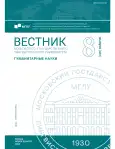DISCURSIVE STATUS AND CONCEPTUAL FOUNDATIONS OF PARAPROSDOKIAN AS A MEANS OF IMPLEMENTING THE DEFEATED EXPECTANCY EFFECT (A STUDY OF ENGLISH DISCOURSE)
- Authors: Sokolova V.L.1,2
-
Affiliations:
- Moscow State Linguistic University
- Diplomatic Academy of the Ministry of Foreign Affairs of the Russian Federation
- Issue: No 8(889) (2024)
- Pages: 123-129
- Section: Linguistics
- URL: https://journal-vniispk.ru/2542-2197/article/view/298734
- ID: 298734
Cite item
Full Text
Abstract
The article explores discursive and conceptual means of creating the defeated expectancy effect in English humorous discourse; it argues for using the term ‘paraprosdokian’ to refer to the discursive implementation of the defeated expectancy effect and investigates the discursive mechanism that paraprosdokian is based on. The research findings enable the author to make conclusions about the conceptual structure of paraprosdokian and its interaction with other tropes and extralinguistic information.
About the authors
Vera Leonidovna Sokolova
Moscow State Linguistic University; Diplomatic Academy of the Ministry of Foreign Affairs of the Russian Federation
Author for correspondence.
Email: sokolova_mglu@mail.ru
PhD (Philology), Associate Professor, Associate Professor at the Department of English Stylistics Faculty of English Moscow State Linguistic University, Associate Professor at the Department of English Diplomatic Academy of the Russian Federation
Russian FederationReferences
- Kanashina, S. V. (2017). Stylistic device of defeated expectancy as a specific communicative strategy in internet memes. Tomsk State Pedagogical University Bulletin, 10(187). 9–14. (In Russ.)
- Leonteva, T. I. (2007). Sposoby sozdaniya effekta obmanutogo ozhidaniya v literaturnom proizvedenii = Ways of creating the defeated expectancy effect in fiction. Papers of Far Eastern Federal University, 146, 91–94. (In Russ.)
- Barsukova, S. S. (2014). Priemy sozdanija effekta obmanutogo ozhidanija na urovne predlozhenija = Means of creating the defeated expectancy effect at the sentence level. The Philology and a Person (pp. 134–138). Barnaul: Altai State University Publishers. (In Russ.)
- Efimova, N. N. (2013). Enantiosemy as allophrony: linguosemiotic aspects. Bulletin of Irkutsk State University, 2(23), 140–150. (In Russ.)
- Galperin, I. R. (1958). Ocherki po stilisike angliiskogo jazyka = Notes on English Language Stylistics. Мoscow: Foreign Languages Publishing House. (In Russ.)
- Belyaevskaya, E. G. (2013). Modelling Stylistic Figures in Discourse. Vestnik of Moscow State Linguistic University, 17(677), 7–17. (In Russ.)
- Sokolova, V. L. (2023). Typology and Communicative Potential of Discursive Programming Depending on Its Orientation and Qualitative Properties (a Study of English Discourse). Vestnik of Moscow State Linguistic University. Humanities, 7(875), 119–125. (In Russ.)
- Riffaterre, M. (1959). Criteria for style analysis. Word, 15(1), 154–174.
- Sokolova, V. L. (2013). Stylistic Clusters in English Media Discourse: Structural Features and Pragmatic Potential. Vestnik of Moscow State Linguistic University. Humanities, 17(677), 70–78. (In Russ.)
- Shmeleva, E. S. (2019). Lingvokognitivnyye modeli kalambura v angloyazychnykh mediynykh zagolovkakh = Linguacognitive models of pun formation in English language media titles: PhD in Philology. Moscow. (In Russ.)
Supplementary files










